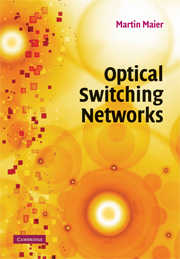Book contents
- Frontmatter
- Contents
- List of illustrations
- List of tables
- Preface
- Acknowledgments
- Part I Introduction
- Part II Optical wide area networks
- Part III Optical metropolitan area networks
- Part IV Optical access and local area networks
- Part V Testbeds
- 19 What worked and what didn't
- 20 Testbed activities
- 21 Summary
- Bibliography
- Index
20 - Testbed activities
from Part V - Testbeds
Published online by Cambridge University Press: 10 May 2010
- Frontmatter
- Contents
- List of illustrations
- List of tables
- Preface
- Acknowledgments
- Part I Introduction
- Part II Optical wide area networks
- Part III Optical metropolitan area networks
- Part IV Optical access and local area networks
- Part V Testbeds
- 19 What worked and what didn't
- 20 Testbed activities
- 21 Summary
- Bibliography
- Index
Summary
GMPLS
LION
The European IST project Layers Interworking in Optical Networks (LION) is a multilayer, multivendor, and multidomain managed IP/MPLS over automatic switched optical network (ASON) with a GMPLS-based control plane (Cavazzoni et al., 2003). The ASON framework facilitates the set-up, modification, reconfiguration, and release of both switched and soft-permanent optical connections (lightpaths). Switched connections are controlled by clients as opposed to soft-permanent connections whose set-up and teardown are initiated by the network management system (NMS). An ASON consists of one or more domains, each belonging to a different network operator, administrator, or vendor platform. The points of interaction between different domains are called reference points. Figure 5.1 depicts the ASON reference points between various optical networks and client networks which are connected via lightpaths. Specifically, the reference point between a client network and an administrative domain of an optical network is called user-network interface (UNI). The reference point between the administrative domains of two different optical networks is called external network-network interface (E-NNI). The reference point between two domains (e.g., routing areas) within the same administrative domain of an optical network is called internal network-network interface (I-NNI). The LION testbed comprises three domains consisting of optical adddrop multiplexers (OADMs) and optical cross-connects (OXCs) from different vendors. For video-over-IP (VoIP) and computer-aided design (CAD) applications, the set-up and tear-down of soft-permanent connections through different domains using GMPLS signaling and interworking NMSs was experimentally validated. Furthermore, multilayer resilience tests were successfully carried out demonstrating MPLS fast reroute combined with optical restoration using a holdoff timer at the IP/MPLS layer.
- Type
- Chapter
- Information
- Optical Switching Networks , pp. 274 - 282Publisher: Cambridge University PressPrint publication year: 2008



